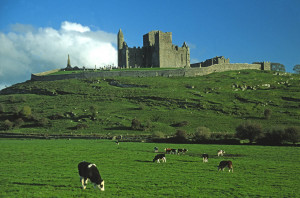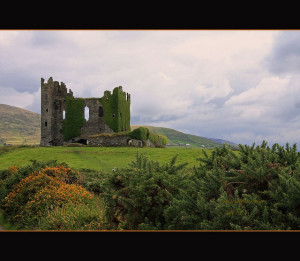
Ireland’s Cashel Rock, also known as St. Patrick’s Rock, in County Tipperary, Ireland. Photo by Dennis Cox/WorldViews.
I admit I was a little surprised several years ago when I toured the entire island of Ireland and discovered that St. Patrick — the patron saint of Ireland and largely credited with bringing Christianity to Ireland — actually did much of his missionary work and is reputedly buried in County Down, which is now part of Northern Ireland, which is part of the United Kingdom.
It was just over two decades ago (April 1998) that “The Troubles,” as they were called — an often violent class-related and sectarian three-decade conflict in Northern Ireland between those who wanted to remain in the UK (mostly Protestants) and those who wanted to break away and join the Republic of Ireland (mostly Catholics) — ended in the Good Friday Agreement to settle the issue peacefully.
Because my grandfather was a Protestant born in County Fermanagh, in what is now Northern Ireland, before he immigrated to America, I never saw myself as completely Irish, but rather “Scots Irish.” My grandmother, to be sure, was born in County Monaghan, now part of the Republic of Ireland, but historically it’s part of the northern Ulster province, and still considered a border region.
Sure, I wore green on St. Patrick’s Day (like everyone else who becomes Irish for a day) and developed a taste for Guinness, but because I grew up as a Protestant in a mostly tea-totaling family, I had generally identified more with the British side of my family than the Irish, or at least what I thought of as Irish.
Discovering the Real St. Patrick
Then, when I had a chance to actually visit my ancestral Northern Ireland home, a few years after The Troubles ended, I discovered that Ulster is just as Irish as the Ring of Kerry or the Blarney Stone.
Take St. Patrick as a case in point.
As mentioned, he’s credited with bringing Christianity to Ireland in the 5th Century AD, and, among other heroic deeds, driving the snakes off the Emerald Isle. The first is only partly true, and the second is almost certainly not true — Ireland is too cold and damp for snakes to live there anyway.

A scene in County Down, where St. Patrick converted the Irish chiefs to Christianity. Photo from Maureen on Flickr.
But he was a larger-than-life figure — born in Britain to boot.
According to my knowledgeable guide from the St. Patrick Centre in County Down, Northern Ireland, St. Patrick was born in Britain and was captured and brought to Ireland at age 16, when he was sold into slavery.
He spent six years working as a shepherd, praying for divine guidance. After escaping on a boat to France, he returned to Britain and trained to become a bishop in the church. Then, following a prophetic dream, he returned to Ireland — what is now County Down in Northern Ireland — where he converted the local chiefs, who in turn helped convert their subjects.
While there were some Christians in Ireland before St. Patrick’s arrival some 1,600 years ago, he had the charisma and therefore gets the lion’s share of the credit for establishing what was known as the “Celtic Church.”
St. Patrick’s Legend Grows
As for St. Patrick driving out the snakes who were never there, they were symbolic of the pagan idolatry and evil that was prevalent before the Irish converted to Christianity. Hence he drove out the “snakes.”
(It’s believed that 8th Century Irish monks engaged in a fair bit of fanciful hagiology — embellishing St. Patrick’s biography — thus adding to his legend.)
St. Patrick is said to be buried on the Hill of Down at Down Cathedral, which sits on the site of an old monastery (a number of churches have subsequently been destroyed there), but no one knows for certain.
In any event, it’s become a place of pilgrimage for the devout, and on March 17 — the day St. Patrick is said to have died — an ecumenical service is held here, bringing Catholics and Protestants together.
The St. Patrick Centre is located two hours north of Dublin and about 40 minutes south of Belfast, and well worth a visit.
Other Northern Ireland Sights
And while you’re in the neighborhood, check out once war-torn Belfast — where the Irish pubs are just as lively as those to the south — and the great natural wonder called the Giant’s Causeway, along the rugged and very scenic northern coast in County Antrim near the Old Bushmills Distillery.
The “causeway” — a UNESCO World Heritage Site — consists of thousands of basalt columns that join together to form stepping stones that eventually disappear into the North Channel, which separates Ireland from Scotland.
The columns were formed by an ancient volcanic eruption. But legend has it that an Irish giant named Finn MacCool built the causeway across the channel to fight a Scottish giant, then retreated when he saw the immense size of the Scot. Disguising himself as his own baby, Finn convinced the Scottish giant that the father of such a baby must be even more immense than he, causing him to flee back to Scotland and destroy much of the causeway to prevent Finn from following.
Somehow, though, causeway or no, many Scots did make their way to northern Ireland and many of their Irish-born descendants eventually made their way to America, as did Richard Lunny and his bride, Jennie Stephenson, my maternal grandparents, who met and married in Ann Arbor, Michigan, in the early 1900’s.
And so I salute all Irish on St. Patrick’s Day, those in or from the Republic of Ireland as well as those in or from Northern Ireland. And I’m glad to declare myself as Irish as St. Patrick on March 17.
Portions of this post originally appeared on StrideTravel.com, the premier online information source for organized travel worldwide.













Leave a Reply